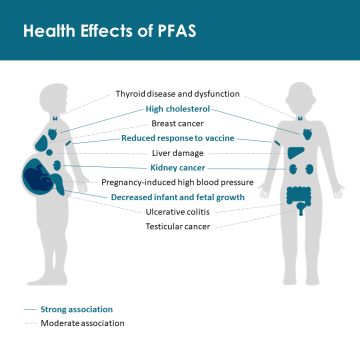PFAS Health Effects & Ways to Reduce Exposure
PFAS are a large group of human-made chemicals. They can affect human health at low levels and can accumulate in the human body. They’ve been used for over 50 years and continue to be used in everyday products. They don’t break down easily and are now common in the environment. It’s important to limit your exposure as much as possible to protect your health.

How PFAS May Affect Your Health
Most people are exposed to a mixture of PFAS chemicals. Not all PFAS chemicals stay in the body for the same amount of time or have the same toxicity. More research is needed to know what levels of PFAS cause health effects.
Current research shows PFAS exposure may cause:
- Thyroid disease and dysfunction
- High cholesterol
- Breast cancer
- Reduced response to vaccines
- Liver damage
- Kidney cancer
- Pregnancy-induced high blood pressure
- Decreased infant and fetal growth
- Ulcerative colitis
- Testicular cancer
How You are Exposed to PFAS
Almost everyone has been exposed to PFAS from the environment or using products that have PFAS. Most exposure is when you’re eating or drinking. It is impossible to avoid some exposure to PFAS.
- PFAS can get into your drinking water in many ways. Learn more about PFAS and your drinking water.
- Some lakes, streams, and ponds are contaminated with PFAS, which has contaminated some of the fish. When you eat these fish, you are exposed to PFAS.
- When the products you use that have PFAS wear out, they can release dust particles that may have high levels of PFAS.
- PFAS can get in the soil near places that made or used PFAS chemicals. Food grown or raised near these sites can have PFAS in it. Soil can have much higher amounts of PFAS than water, so it can carry higher amounts of PFAS into your body.
- PFAS are a key ingredient in the coating of most non-stick cookware. PFAS can transfer from the cookware into your food at normal cooking temperatures.
- Fast food wrappers and containers that are oil and grease resistant can contain PFAS, which can transfer into your food.
Ways to Reduce Your Exposure to PFAS
It’s hard to avoid exposure to low levels of PFAS. Reduce or limit your exposure when you can, prioritizing drinking water and food. The human body does get rid of PFAS after a period of time. Limiting your exposure can reduce the levels of PFAS in your body.
Drinking Water
- Know how much PFAS is in your water or filter your water with NSF/ANSI certified filters. Most water utilities test for PFAS and you can contact them for results.
- If you’re on a private well, have your water tested and filter it if needed to limit your exposure.
Food
- Follow fish eating guidelines for Dane County.
- Reduce or limit the amount of fast food, microwave popcorn, and takeout you eat.
- Reduce or limit your use of non-stick cookware. Stainless steel or cast iron are good PFAS-free alternatives.
- Note: Cookware that says it is PFOA-free and PFOS-free does not mean PFAS free! PFOA and PFOS are two specific older PFAS chemicals. In cookware that says PFOA and PFOS free, they may have newer PFAS compounds that could still be harmful to health.
- Wash fruits, vegetables and hands well before eating.
Spending time in our local waters
- Wash hands before eating if you’ve touched foam or been in lakes, streams, and rivers.
- Avoid accidental swallowing of water in lakes, streams, and rivers for yourself and your pets.
- Rinse or shower after being in lakes, streams, and rivers. Do the same for pets.
In your home
- Choose furniture and carpets that are not labeled “stain-resistant,” and don’t apply stain resistant treatments to items.
- Check product labels for ingredients that include the words “fluoro” and “perfluoro” and don’t use them.
- Household dust can contain PFAS that was shed from items that have PFAS in them. Vacuum often to pick up dust.
- Replace or remove worn products with newer, PFAS-free items.


